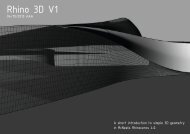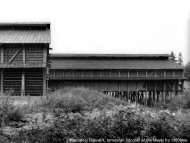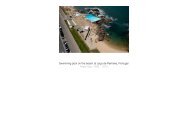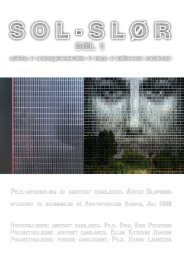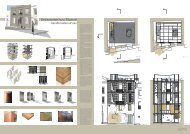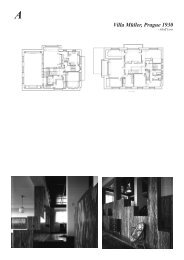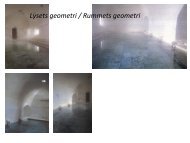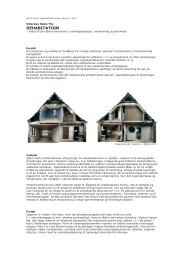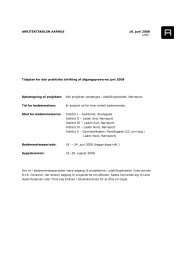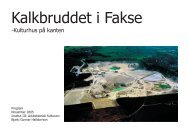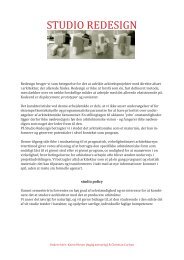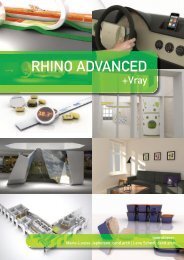Morphogenetic Studio - Rum
Morphogenetic Studio - Rum
Morphogenetic Studio - Rum
You also want an ePaper? Increase the reach of your titles
YUMPU automatically turns print PDFs into web optimized ePapers that Google loves.
<strong>Morphogenetic</strong> <strong>Studio</strong><br />
Phase 1<br />
15.09.2010-15.10.2010<br />
The first phase is an investigation of principles for versatile parametric or self-organizing spatial systems. They can be<br />
inspired by biological, physical, geometrical or architectural organizational principles, but the main point is to identify<br />
non-uniform systems that are able to create diverse and unpredictable results. Focus should be on bottom-up processes:<br />
how individual shapes, elements, attractors can form complex wholes. Phase 1 is carried out in three shorter<br />
steps: The first step is aimed at the identification and analytical description of relevant systemic principles; the second<br />
step is aimed at producing a physical model that explores these principles, and the third step is aimed at transferring<br />
the experiences of the physical model into a digital model.<br />
Phase 1.1<br />
15.09.2010-21.09.2010<br />
The first step is aimed at identifying and analyzing organizational geometrical or spatial principles that could form the<br />
basis of further studies. We encourage you to look for organizations that are systematic and ordered in non-uniform<br />
ways. By non-uniform we mean systems that are able to create diverse and unpredictable results. A flock of birds or a<br />
school of fish where each animal has independent movements but adjust its speed and directions to the neighbours<br />
could be one example of a non-uniform system, in opposition to an orthogonal grid where each cell is identical to the<br />
next one. The system may be inspired by organizational principles found in biology, physics, geometry, architecture or<br />
something completely different. At this early stage the spatial characteristics are of less importance (plenty of time for<br />
that later). In fact in many cases it might be better to look at 2D principles that might be easier to analyze and describe.<br />
The focus of the analysis should be from a bottom-up perspective. That means how do elements or shapes join to create<br />
larger entities. In order to promote this view we want you to describe the organizational principle with focus on a<br />
single element. How does it relate to other elements? In additional processes where one element is joined to the next<br />
one after the other? Or in processes where several elements relate to each other at the same time (as for instance in<br />
flocking) or in processes that diversify the elements through subdivisions or branching? Is the organizational principle<br />
based on geometry, such as proportions, angles and dimensions? Or perhaps forces, distances or …? We want you to<br />
present your selected principle through a short text and in diagrams that analyse and describe how the principle functions.<br />
The main point of this first step is to identify and describe relations and rules in a clear and diagrammatical way, so it<br />
can form the basis on further investigations in the following steps. There is no point in finding the most complex principle,<br />
if this couldn’t be described diagrammatically.<br />
The chosen principle should be explained in diagrams, through reference images and sketches, using the course indesign<br />
template.<br />
Over the run of the course, each group of students are asked to record the progress of their project in a book, using<br />
the ‘morphogenetic interferences’-layout on the intranet. This template should also be used for all presentations and<br />
reviews. The final book will be a collection of all presentations.
DorphoEene9F InterferenFes <strong>Studio</strong><br />
September 2010<br />
week 37 13 14 15 16 17 18 19<br />
Monday Tuesday Wednesday Thursday Friday Saturday Sunday<br />
Topic Phase 1.1 Seminar Inst I<br />
AocaBon<br />
Studsgade <br />
Seminar space<br />
GymnasBksalen<br />
Descripton<br />
10:00, Welcome <br />
and IntroducBon<br />
self study<br />
09:15 Interference <br />
Seminar<br />
Erik W Petersen Erik <br />
Steffensen Karl Aage <br />
Rasmussen<br />
September 2010<br />
week 38 20 21 22 23 24 25 26<br />
Monday Tuesday Wednesday Thursday Friday Saturday Sunday<br />
Topic<br />
AocaBon<br />
End of Phase 1.1 <br />
Presenta9on<br />
Nørreport 15 <br />
Basement<br />
Phase 1.2<br />
Descripton Self study self study self study self study<br />
13:00 PresentaBon <br />
15:00 IntroducBon <br />
Phase II<br />
15:00 InsBtue <br />
lecture -‐ KrisBne <br />
Jensen<br />
September 2010 October 2010<br />
week 39 27 28 29 30 1 2 3<br />
Monday Tuesday Wednesday Thursday Friday Saturday Sunday<br />
Topic<br />
Phase 1.2<br />
Grasshopper <br />
Course<br />
End of Phase 1.2 <br />
Presenta9on<br />
AocaBon<br />
Nørreport 15 <br />
Basement<br />
Nørreport 15 <br />
Basement<br />
Nørreport 17 <br />
Basement<br />
Descripton self study self study 9:00 -‐ 16:00 9:00 -‐ 16:00 10:00 PresentaBon,<br />
Grasshopper Grasshopper 16:00 IntroducBon <br />
Phase III<br />
`<br />
October 2010<br />
week 40 4 5 6 7 8 9 10 t<br />
Monday Tuesday Wednesday Thursday Friday Saturday Sunday<br />
Topic Phase 1.3<br />
AocaBon<br />
Descripton self study self study self study self study self study<br />
October 2010<br />
week 41 11 12 13 14 15 16 17<br />
Monday Tuesday Wednesday Thursday Friday Saturday Sunday<br />
Topic<br />
AocaBon<br />
Phase 1.3<br />
End Phase 1.3 <br />
Presenta9on<br />
Nørreport 17 <br />
Basement<br />
Descripton self study self study self study self study 10:00 PresentaBon<br />
October 2010<br />
week 42 18 19 20 21 22 23 24<br />
Monday Tuesday Saturday Thursday Friday Saturday Sunday<br />
Topic<br />
Autumn Break<br />
AocaBon<br />
Descripton



